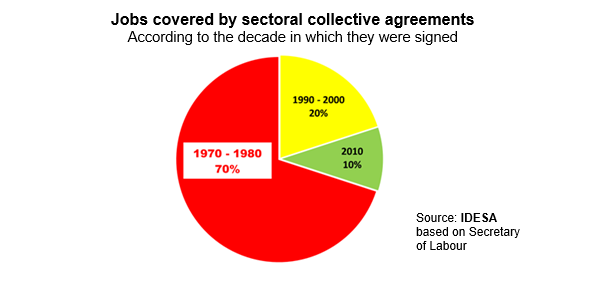Report Nº: 112722/06/2025
One of the biggest obstacles to competitiveness is the obsolescence of collective bargaining agreements. Most date back to the 1970s and 1980s. The solution lies in enabling SMEs to negotiate agreements with their workers, breaking away from sectoral agreements.

The INDEC reported that in the first quarter of 2025, the workforce grew compared to the same period last year, with 75% finding employment and the remaining 25% joining the unemployed. This is why the unemployment rate rose. But what is most worrying is that the increase in employment was entirely in the informal sector. This is a long-standing process of labor degradation.
Since 2012, registered private wage employment has remained stagnant at around 6 million workers. There was no job destruction, thanks to a 25% slump in real wages during the same period. But with the decline in inflation, the flexibility provided by the fall in real value of labor costs ceases to operate. Therefore, the adjustment will now take the form of a decline in formal employment. This underscores the urgency of modernizing labor institutions. Faced with this challenge, with the elimination of severance pay surcharges, the dismissal regime is no longer the most important issue. The ones that most damage employment now are the exacerbated litigation in the occupational risk system and the obsolescence of collective bargaining agreements.
Regarding collective bargaining, according to the December 2024 survey published by the Secretary of Labor, it can be observed that:
These data show the frightening age of most centralized collective agreements. There are at least 3 million wage earners who are governed by collective agreements signed when there was not even the internet. The main damage is that more than two-thirds of these workers are employed by SMEs. Larger companies can deal with archaic rules, and many negotiate their own collective agreements. But SMEs are subject to irrational regulations that are often directly inapplicable, generating labor disputes and hindering productivity.
Sectoral collective agreements are a powerful source of inefficiency. There are cases, such as that of metalworkers, which have more than 1,500 occupational categories defined in 1975 when processes were manual and Fordist, rather than automated and digital as they are today. It is also common in agreements, for example, to include a large number of union delegates, display cases, blackboards, and time for assemblies when communication now flows through WhatsApp. Another of the most harmful consequences is that they force the application of equal pay scales to very heterogeneous universes of companies and workers, preventing performance from being rewarded.
Sectoral collective agreements arise from negotiations between a small group of business and union leaders. What they agree upon is mandatory for all employers and workers in the sector, even if they do not belong to the business chamber or the signatory union. The way to impose rules defined at the top level on the entire sector is through the approval of the agreement. This State’s intervention in an agreement between private parties is cumbersome, bureaucratic, and discretionary, adding legal uncertainty and labor conflicts.
The solution is not –as the CGT, the main central union, claims– to relax state intervention in the approval process. Nor is it to eliminate ultra-activity so that business chambers and unions are obliged to enter into new sectoral agreements. What must be avoided are sectoral agreements that impose rules centrally, imposing inflexible rules on SMEs. The solution is to enable the employers to opt out of the sectoral agreement. That is, employers should have the possibility of agreeing with their workers on their own agreement overriding the sectoral agreement. Giving this freedom to negotiate will allow for more efficient and equitable regulations that are more in line with formal job creation than the current atavistic collective labor agreements.